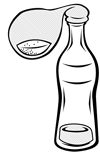Loony Balloons

How can you blow up a balloon without ever putting it to your lips? Learn how in this lab that uses common household items and is great for all different age levels.
You will need an empty water bottle, a balloon, a funnel, vinegar and baking soda. First measure about 1/3 of a cup of white vinegar and pour it into the water bottle. Now place the funnel in the opening of the balloon and pour about 3 teaspoons of baking soda into the balloon. This next part is a little tricky, so if you are working with younger children, you may want to make sure they have adult supervision on this so they do not get too frustrated. Attach the open end of the balloon over the mouth of the water bottle, while letting the balloon with the baking soda dangle over the side of the bottle. Now raise the end of the balloon up so that the baking soda drops into the vinegar. In just a few moments, the balloon will begin to fill and you will have blown up a balloon without using your lips!
One of the products formed in this reaction is Carbon dioxide gas and that is what inflates the balloon. For younger students, you can use it to introduce the 3 phases of matter. Tell them that in this lab you will use a solid (baking soda) and a liquid (vinegar) and you will create a gas (CO2). You can double this recipe and you will inflate the balloon a little larger.
I use this experiment for my High School Chemistry class when I am teaching limiting reactants. In my method, we perform the experiment 3 times. We keep the amount of vinegar the same each time, but we keep adding more baking soda. The first trial has 2.5 g (or about 1 teaspoon), the second has 5 g and the third has 10 g. Of course the students think that the balloon will get larger each time (we use a string around the balloon to measure its circumference so we have quantified data), however it has almost the same circumference in the second and third trial. That is because we use up all the vinegar when we have 5 g of the baking soda. Even though we add more baking soda, we do not have any vinegar left for it to react with; the vinegar is our limiting reactant.
Enjoy!
